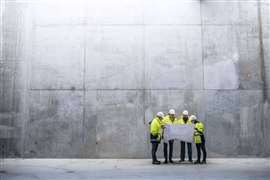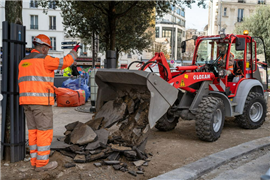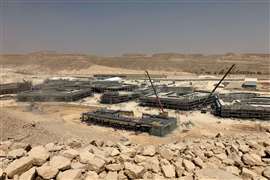Automating and innovating concrete with technology
30 March 2022
Meeting sustainability targets is driving the concrete industry to innovate its processes and create ‘smart’ technology, reports Catrin Jones.
As the most widely used manufactured material, concrete can be found in construction projects across the world – but that comes at a price to the environment. The concrete supply chain also brings a host of negative effects, such as noise, pollution, and carbon dioxide.
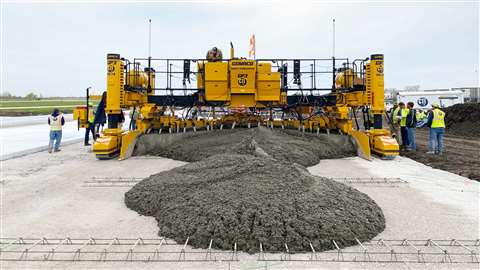 GOMACO’s GP3 Slip Form Paver (Photo: GOMACO)
GOMACO’s GP3 Slip Form Paver (Photo: GOMACO)
The production of concrete contributes significantly to global carbon dioxide (CO₂) emissions – around 8% in total, according to think tank Chatham House.
But concrete is indispensable for modern construction. This applies to high-performance engineering structures as well as the provision of urgently needed housing space.
The building materials industry is reacting to increasing demands with high-performance concretes, new resource-saving construction methods, and concrete types specially adapted to maintenance measures, as well as future-oriented solutions with innovative technologies, such as 3D concrete printing.
“Observing the developments in the industry is important,” says Ernst Stöttinger, sales director of concrete mixing technology at SBM Mineral Processing. “We actively contribute to the design of standards and technical
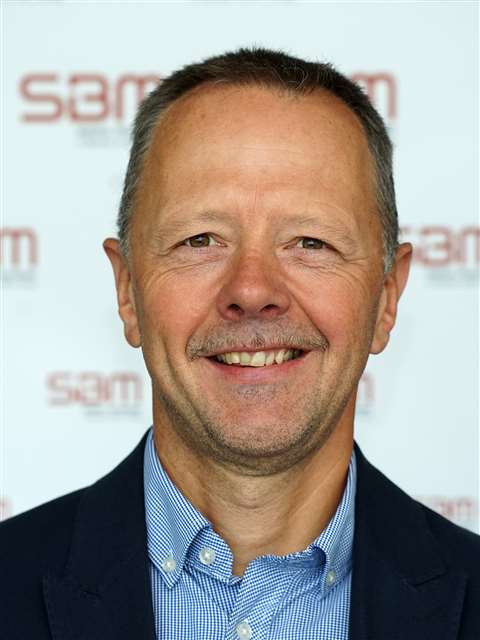 Ernst Stöttinger, concrete mixing plants sales director at SBM (Photo: SBM)
Ernst Stöttinger, concrete mixing plants sales director at SBM (Photo: SBM)
requirements on the production side and constantly adapt our technologies, especially with regard to new additives or additional processing steps.”
Is concrete sustainable?
To meet increasingly stringent environmental targets, concrete techniques and equipment must consider their impact on the environment. Greater adoption of clean and environmentally sound technologies and industrial processes are key.
Marco Polastri, sales, aftersales and marketing director, Cifa, knows that much work is required to meet these targets. “Taking a common and coordinated action throughout the sector is necessary to achieve the sustainability goals, starting from design and construction, up to the management of buildings and their demolition,” he comments.
“Therefore, the construction sector has a duty to look for new alternatives to diesel fuel, opening up to more sustainable solutions, which also guarantee savings from an economic point of view.”
Whilst Cifa’s concrete mixers and mixer pumps are currently mounted on traditional diesel vehicles, they are making progress towards fully electric alternatives. Talking about the benefits of moving from hybrid to greener solutions, Polastri comments, “The advantages of using our electric solutions are many: less noise, zero emissions, and even lower consumption, for a cleaner environment.”
The company’s Energya mixers can work in fully electric mode, while Cifa’s hybrid Energya range is based on a handling system that is said to combine the advantages of traditional technology with those of electricity.
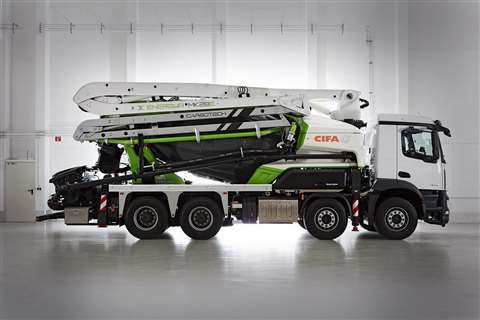 Cifa’s hybrid Energya range is said to combine the advantages of traditional technology with those of electricity (Photo: Cifa)
Cifa’s hybrid Energya range is said to combine the advantages of traditional technology with those of electricity (Photo: Cifa)
“The movement of the concrete mixer drum is guaranteed by an electric induction motor that receives energy from a lithium-ion battery, which in turn can be recharged either by mains power or by an on-board generator. Thanks to the Kinetic Energy Recovery System, Energya machines can recover energy during the deceleration phase of the vehicle, which would otherwise be lost.”
Concrete’s carbon footprint
One of the ways that the industry can become more sustainable is by being as efficient as possible. This is something that Kevin Klein, VP of Engineering and R&D at GOMACO, picks up on. He comments that all of the company’s equipment, “operates at the latest emission control standards. The controls have been designed to utilise and operate the most efficient hydraulic systems on the market, improving power consumption throughout the paving process.”
Klein adds that concrete pavements are the most sustainable type of road surface because, “they are long lasting, made from locally sourced raw materials – not petroleum based, and they actually absorb CO2 from the atmosphere. Concrete pavements are 100% recyclable, reduce ‘heat island’ effect, and provide for increased vehicle fuel efficiency.”
There is a growing demand from customers for greener alternatives; the industry must meet this demand. It is for this reason that Betolar Plc and JA-KO Betoni signed a license agreement for the low-carbon Geoprime concept. JA-KO Betoni, a concrete company, has bought the right to utilise the Geoprime materials technology solution in the manufacture of its products.
The agreement will see Betolar’s Geoprime solution, which converts industrial by-products into a cement substitute using 80% less CO2 emissions, utilised in JA-KO Betoni’s infrastructure products.
“The agreement is a great step in the green revolution in the concrete industry and a response to the construction industry’s need to bring low-carbon products to market,” said Matti Löppönen, CEO of Betolar.
The partnership aims to help global infrastructure developers who are under pressure to lower CO2 emissions for projects and help countries hit net-zero targets.
Concrete digital innovation
Companies are turning to digital solutions to help them meet sustainability targets in the concrete sector. Construction has traditionally been slower at adopting these processes, but is currently experiencing an increasing implementation of digital technologies.
“We believe that digital tools are a crucial factor in building a sustainable future,” says Paul O’Hanlon, R&D project manager at Holcim Innovation Centre.
“We are conducting studies on how we can utilise digital solutions like I-Concrete Maturity, a digital tool, to provide our customers with a real-time estimation of in-situ compressive strength, in conjunction with our ECO Pact range of low carbon concrete, to demonstrate the benefits of utilising our green concrete on construction projects.”
Holcim says that they are taking great strides to implement digital initiatives into their projects and supply smart concrete solutions. Digital tools can enhance the speed of decision making, improve environmental loadings and productivity, and help in mitigating risk.
The annual international trade show for the construction and masonry industry, World of Concrete (WOC), took place in January in Las Vegas, US. The event highlighted that greater job site productivity is a growing trend and the entrance of new materials and streamlined management systems are bringing this to fruition.
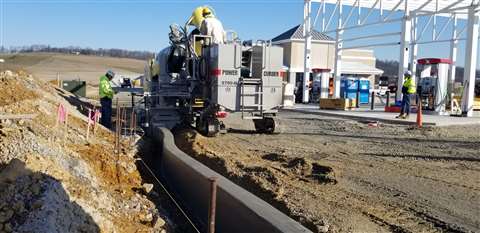 Power Curbers’ 5700-D Ribbon Curb (Photo: Power Curbers)
Power Curbers’ 5700-D Ribbon Curb (Photo: Power Curbers)
At the show Power Curbers introduced a new ConnectSmart Telematics solution – offering a variety of fleet management tools and visibility to slip forming contractors.
Companies can monitor their Power Curbers and Power Pavers equipment on a real-time dashboard accessible with a web browser or app on mobile devices.
Schwing also exhibited at WOC, and the company recently released a new S 56 SXF truck-mounted concrete pump designed with buffer and low wear – replacing the S 55 SX in the field of large boom pumps.
The weight of the S 56 SXF can be reduced by more than 2.5 tons with the same equipment. Additionally, the mast design has been optimised to avoid overhead roll-and-fold boom, which Schwing says, gives customers greater freedom when it comes to choosing the chassis and the desired engine.
As with the larger S 65 SXF, the patented ‘foldable’ arch outriggers have been integrated to support Schwing’s P2525 long-stroke pump kit with 2.5m long delivery.
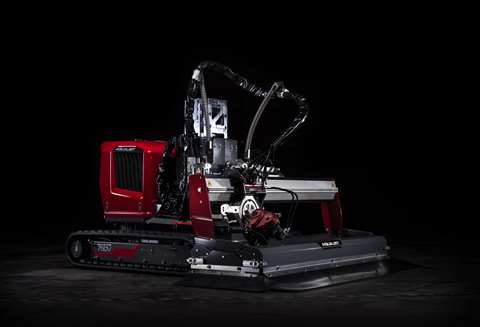 Aquacutter showed the 750V at World of Concrete (Photo: Aquacutter)
Aquacutter showed the 750V at World of Concrete (Photo: Aquacutter)
At the US-based event Aquajet introduced its newest Hydrodemolition robot, the Aqua Cutter 750V. The new model launches Aquajet’s patented Infinity oscillation that moves the water jet in an infinity – or figure eight – pattern, removing more concrete in a single pass while reducing shadowing, eliminating the risk of pipe holes and providing an ideal bonding surface.
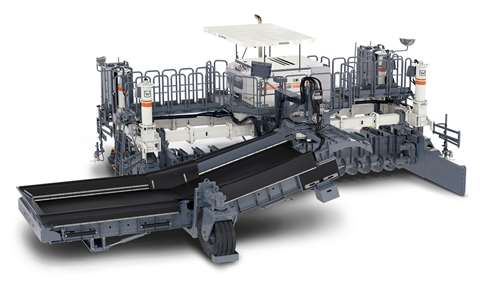 The cost-effective two-track placer/spreader WPS102i is designed for high-performance concrete feeding (Photo: Wirtgen)
The cost-effective two-track placer/spreader WPS102i is designed for high-performance concrete feeding (Photo: Wirtgen)
The 750V also features the next generation Evolution 3.0 Control System, which includes the ability to automatically calculate optimal settings for lance motion.
Remote support and automation
Major manufacturer Wirtgen has long been at the forefront of technology development in this sector, and at WOC showed its fleet software that can support fleet managers remotely. The WITOS FleetView has been installed on the new SP 102i inset slip form paver, which has been released for the North American market. It will supply a telematics solution to increase machine availability by prompt identification, planning and execution of required maintenance and servicing.
The WITOS FleetView also enables access to positioning and machine data, in addition to all status information. Management systems that increase job productivity are on the rise – the automation of concrete processes could be key to this.
Stöttinger, from SBM Mineral Processing, agrees that a high degree of automation in the industry is becoming standard. “For ‘developed’ markets, where, in addition to many standardised concrete recipes, the necessary documentation is no longer manageable without an intelligent control system,” he says.
“Even those who provide only a few types of concrete will benefit from the constant quality based on an integrally monitored production process.”
Keeping up with automated trends is key, and Stöttinger adds that, “Depending on the task at hand, we integrate the weighing/dosing of all concrete components – from aggregates and binders to fibre constituents of colour pigments.
“Especially in the stationary area, we also integrate fully automated conveying solutions for aggregates or end products into our control architecture. This applies to high-capacity aggregate warehouses as well as to concrete bucket conveyors in precast plants.”
A greener future for concrete will be driven by the implementation of automation and technology.
Reinforced concrete for super clinicA super clinic in Denmark is being built with reinforced concrete construction. 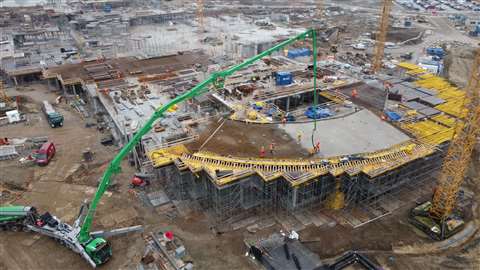
The super clinic includes the construction of the Nyt Hospital Nordsjælland, including the landscape architecture. The project has been supported by Paschal-Danmark A/S since the start of the structural and reinforced concrete work in summer 2020. The hospital complex has a floor area of 128,000 m² and is founded on a load-bearing reinforced concrete floor slab that is up to 75 cm thick. The base floor covers an area of 32,000 m² and has a clearance height of 5.33m. To create the reinforced concrete exterior walls of the basement, NCC used around 2,500m² of LOGO.3 wall formwork. The ground floor, as well as the two upper floors, are dominated by prefabricated reinforced concrete elements in the form of wall elements and columns. To achieve the necessary structural stiffening on these floors, some wall slabs are being constructed in in-situ concrete, for which the LOGO.3 wall formwork system is used. |
STAY CONNECTED


Receive the information you need when you need it through our world-leading magazines, newsletters and daily briefings.
CONNECT WITH THE TEAM









